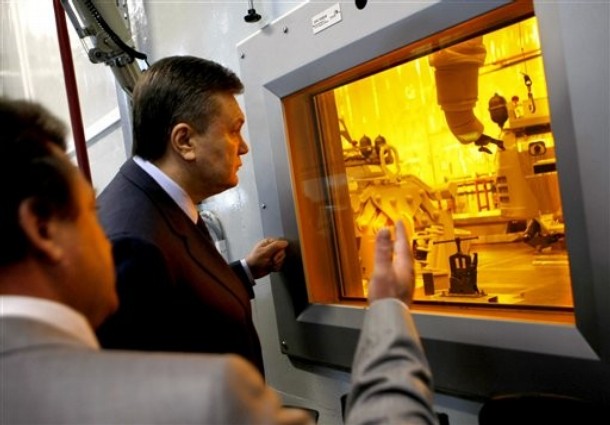
"We should build a new framework for civil nuclear cooperation, including an international fuel bank, so that countries can access peaceful power without increasing the risks of proliferation. … We must harness the power of nuclear energy on behalf of our efforts to combat climate change, and to advance peace and opportunity for all people."
— President Barack Obama, Prague, April 2009
Much has been written over the past several months about America’s nuclear strategy. The topics range from the Strategic Arms Reduction Treaty to the Obama administration’s Nuclear Posture Review, the Non-Proliferation Treaty Review Conference, the Global Zero movement, Russian tactical nuclear weapons and Iran’s nuclear program.
Noteworthy is that this discussion focuses solely on nuclear weapons. Another aspect of nuclear strategy has garnered much less attention, but is no less important to our nation and our planet: the need for American leadership in ensuring that the ongoing global expansion of nuclear energy capacity is as environmentally safe and proliferation-resistant as possible. Despite President Obama’s exhortation, U.S. government and industry as a whole have a long way to go in getting America back at the table.
As if concerns over global warming had not been enough, the just-capped Gulf of Mexico oil spill highlights the potential of nuclear energy: significant quantities of electricity, produced with no greenhouse gas emissions and far greater reliability in supplies.
The risks of nuclear power generation are also great: Chernobyl and Three Mile Island stand as reminders of what can go wrong. Nuclear waste disposal remains a major concern. Some technologies are more able to spin off nuclear weapons programs than others. International oversight is imperfect.
Still, calculating all the potential gains and risks, nations around the world are expanding their nuclear power generation capacity at an unprecedented rate. China has announced plans for a vast number of new plants, as has Russia — looking beyond its oil and gas reserves. The United Arab Emirates is building a nuclear reactor. Sweden has abandoned its previous decision to abandon nuclear power, Finland has opted for two more reactors and the Czech Republic has put out a tender. Poland, Hungary, Slovenia, Romania, Bulgaria and others are expanding existing nuclear facilities or building new ones.
At the dawn of the nuclear age, the United States was the leader in nuclear technology and its commercial application. But with a 30-year hiatus in domestic nuclear power plant construction, the industrial edge has shifted. Westinghouse, now owned by Japanese investors, and General Electric are still significant players. But Russia, France, Japan and Korea all are well-advanced in technology and possess significant recent experience in power plant construction and operation.
As the world moves toward a massive expansion of nuclear power generation in the coming decades, the question of who provides the technology and commercial solutions — and under what terms — will shape the global balance of energy markets, strategic relationships, environmental risk and nuclear proliferation risk for generations to come. The United States needs to move swiftly if it wants to have a role in shaping the outcomes.
Several steps are necessary — many are already underway, but can be accelerated.
First, the United States needs to strengthen its own domestic capacity. Thanks to changes in legislation and regulation, the first licenses for new plant construction have already been issued, and new plants are scheduled to come online within the next five to 10 years. This is important for rebuilding human and corporate know-how inside the United States — yet is a slow pace compared with what we see abroad.
Second, continued significant U.S. government funding for research remains critical to developing new technological processes, minimizing proliferation risk and driving down costs.
Third, the United States government needs to champion American companies and help set the framework for their competing successfully. France and Russia are masters of such national promotion, and regularly engage at the head of state and government level. In a visit to Washington, D.C., in May, a former Czech deputy prime minister pointedly noted: "We hear from France and Russia all the time. But where’s Westinghouse?" A recent trade mission to Central Europe led by Commerce Department Under Secretary Francisco Sanchez is a solid start, but we must go much further to put the United States on the map.
Fourth, the United States must actively lead international negotiations to make good on President Obama’s call for establishment of an international fuel bank. This must in particular stress the unacceptability of all but the most proliferation-resistant reactors, while establishing iron-clad reliability of fuel supply.
A major expansion of global nuclear power generation is already well underway, but thus far the United States is barely at the table. The nature and impact of this expansion can still be defined. Considering the implications for strategic relationships, environmental safety and non-proliferation, the United States has a major strategic interest in playing a leading role in this global expansion. But to do so, it will require a major commitment of government and industrial time and resources, starting today.
Kurt Volker is a senior adviser at the Atlantic Council and member of the Council’s Strategic Advisors Group. He is also a former US ambassador to NATO and current managing director of the Center for Transatlantic Relations at Johns Hopkins’ School of Advanced International Studies. This article first appeared in the Pittsburgh Post-Gazette. Photo credit: AP.
Image: Chernobyl%20plant.jpg
